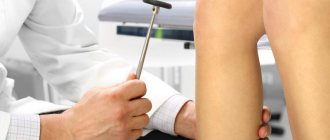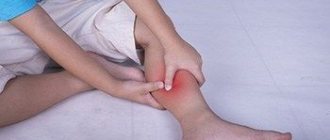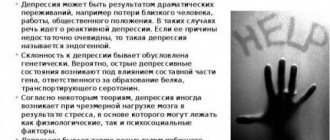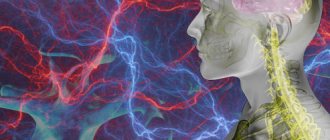Kinds
Before contacting a specialist for qualified help, it is important to determine the type of tingling (the medical definition is paresthesia). Thus, each type of illness speaks of various types of disorders in the body.
- The little finger of the right hand goes numb - the nerves are pinched and cervical osteochondrosis develops.
- Middle finger – damage to the cervical vertebrae of the collar zone occurs.
- Ring finger – if the finger is not pulled over the wedding ring, then muscle strain should be suspected.
- Numbness in the thumbs of the right and left hands - the cause may lie in a basic lack of vitamins, muscle strain or inflammation of the brachial nerve. But you should also be wary of more dangerous diagnoses, namely: pre-stroke condition, disturbances in the functioning of the nervous and cardiac systems.
- The index finger goes numb when the metabolic system does not work properly, or when the nervous system malfunctions due to stress and breakdowns.
- The little finger and ring fingers of the left hand – the functions of the cardiovascular system are impaired.
Why do my fingertips always go numb?
The reasons that most often lead to paresthesia (numbness):
- Wrong lifestyle: bad habits and unbalanced diet. So, if you eat spicy food at night, drink alcohol, strong tea or coffee, pain may occur in the abdomen or head, which forces a person to choose a position during sleep in which the pain disappears. However, these poses are not always comfortable, as a result of which numbness of the limbs may occur, which disappears a few minutes after waking up.
- An uncomfortable pillow can also be the reason why a person’s fingers go numb while sleeping. The use of a dense high pillow leads to a strong deflection of the cervical spine, due to which blood circulation in the nerve endings of the intervertebral discs, which are responsible for the sensitivity of the hands, deteriorates. A special orthopedic pillow will help solve the problem.
- Carpal tunnel syndrome is paresthesia and pain in some fingers or the entire hand. The reason lies in the narrowing of the carpal tunnel and pinching of the median nerve. Most often, this disorder occurs in people who regularly perform monotonous movements of their hands during work, for example, seamstresses, musicians, programmers, drivers. Women suffer from it more often than men due to the smaller width of the carpal tunnel. If the disease is not diagnosed in a timely manner, the patient may lose the ability to perform basic manipulations, for example, holding a toothbrush or cutlery.
- Spinal diseases. Due to compression of the nerve endings in the vertebrae, blood circulation is impaired. In addition to dizziness and pain in the head, a sign of spinal pathologies is numbness of the hands at night
- Vegetovascular dystonia is a circulatory disorder in the autonomic nervous system. Poor functioning of blood vessels is often the reason why fingertips go numb
- Diabetes. With this disease, there is an increase in glucose levels, which causes numbness in the upper extremities.
Other pathologies that can lead to paresthesia:
- diseases of the nervous system;
- cardiovascular pathologies (hypertension, multiple atherosclerosis, Raynaud's disease and others);
- joint diseases, such as arthritis and arthrosis;
- lack of nutrients in the body.
Causes
Paresthesia is not always associated with a painful condition of the body (neuralgia). Non-medical causes of numbness in the fingers include:
- general hypothermia of the body or upper extremities;
- consequence of hand injury;
- sleeping in an unnatural position;
- poisoning of the body with alcohol, drugs, chemicals;
- wearing tight-fitting jewelry (rings, bracelets);
- keeping your fingers in one position for a long time (knitting, typing on the keyboard).
REFERENCE! During pregnancy, a woman may experience numbness in her limbs due to the increased load on the body and hormonal changes.
If tingling is felt with constant frequency and is present in the same limb or finger, you should immediately contact a specialist for timely diagnosis and prescription of effective treatment.
Medical causes of the disease include:
- osteochondrosis;
- intervertebral hernia;
- tunnel syndrome;
- inflammatory processes in the joints;
- failure of the cardiovascular system;
- cerebral hemorrhage;
- brain activity disorders;
- improper blood circulation against the background of developing diabetes mellitus;
- thrombosis;
- disruption of the endocrine system;
- nail fungus;
- avitaminosis.
It should be borne in mind that the proper functioning of the body directly depends on the lifestyle that a person leads. Bad habits have a tremendous impact on the body's ability to function properly.
Prevention of numbness in fingers
You can reduce the likelihood of developing diseases that provoke disturbances in the sensitivity of the fingers if:
- stop smoking and drinking alcohol;
- devote enough time to physical activity every day;
- drink at least 2 liters of water every day;
- avoid hypothermia;
- eat a balanced diet, ensuring that the body receives all the necessary substances;
- when working in a job that involves the need to perform monotonous hand movements for a long time, including at the computer, take regular breaks to do light exercises for the hands and fingers;
- avoid injury;
- Consult a doctor in a timely manner if problems occur in the body.
Thus, numbness in the fingers can be a sign of the development of a number of different diseases. But in most cases, they are based on either vascular disorders or neurological ones. Therefore, this problem cannot be ignored, since existing pathologies will progress over time and can lead to more serious consequences than numbness of the fingers.
4 1 vote
Article rating
Which doctor treats
For regularly recurring attacks of paresthesia, seeking professional medical help is a must. First of all, you need to make an appointment with a neurologist.
When choosing a clinic, you should take into account the presence of its own diagnostic facilities, the experience and qualifications of the working specialists (in particular, neurologists).
ATTENTION! The Kuntsevo Treatment and Rehabilitation Center has an extensive diagnostic base in all possible areas (MRI, ultrasound, electroneuromyography, etc.) to quickly and accurately determine a patient’s diagnosis.
Basic tests and procedures to make a correct diagnosis:
- blood and urine tests;
- blood sugar level analysis;
- Ultrasound, ECG of the heart muscle;
- MRI of the hand;
- Dopplerography of blood vessels, etc.
If necessary, additional studies will be ordered to more accurately diagnose the patient.
Depending on the nature of the origin of the symptom, based on the tests performed, the specialist will prescribe the most effective treatment in each specific case. The clinic employs the best neurologists, orthopedic traumatologists, rheumatologists, endocrinologists, cardiologists, chiropractors, rehabilitation specialists and other specialized specialists with many years of experience.
Numbness of the fingers is a sign that indicates neurological disorders in a person’s limbs.
IMPORTANT! A slight decrease in sensitivity can become a real problem after some time if timely treatment is not started by a qualified specialist.
Self-medication, as in all other cases, threatens not only to complicate the situation, but also to develop other neurological disorders. Therefore, make an appointment with an experienced neurologist at our center, who will conduct a full range of diagnostics, determine the causes of your condition and prescribe effective treatment.
Sign up
Treatment methods
Treatment for numbness in the fingers is carried out in several ways.
- Drug therapy. The doctor selects a course of effective, maximally safe medications, creams or ointments to relieve inflammation, relieve swelling and eliminate severe pain.
- Local treatment. In this case, therapeutic massage or manual therapy is used.
- Physiotherapy. Treatment is carried out with laser, magnet or ultrasound. As a result of this approach, blood circulation in the body is normalized and damaged tissues are regenerated.
- Exercise therapy and gymnastics. Relieves pain, restores normal sensitivity in the limbs, and alleviates the general condition.
IMPORTANT! The priority area of work of the CLRC is conservative therapy. The prescription of powerful, at the same time safe, pain-relieving drugs is combined with manual therapy, physical therapy, physiotherapy and massages. Only an integrated approach will help achieve the desired result quickly and for a long time.
Treatment of numbness in fingers
The nature of therapy directly depends on the type of pathology detected. In some cases, it is enough to fix the hand in a physiological position using an elastic bandage; in others, hypoesthesia goes away thanks to a course of therapeutic massages. But since patients rarely seek medical help when the first signs of the disease appear, most often, to effectively eliminate the underlying disease, complex treatment is required, which may include:
- drug therapy;
- physiotherapy;
- manual therapy;
- physical therapy.
All patients will also be advised to make certain adjustments to their lifestyle. In particular, it is extremely important to give up bad habits, especially smoking, since nicotine negatively affects the condition of the vascular walls and contributes to the development of numbness in the fingers. It is also worth reviewing your diet, giving up processed foods, smoked meats and other unhealthy foods, and in return increasing the amount of vegetables and fruits you consume. This is especially true for anemia, hypovitaminosis and diabetes.
When diagnosing diabetes mellitus, proper nutrition and avoidance of fast carbohydrates is the basis of treatment and prevention of the development of a number of complications, including neurological origin in the form of numbness of the fingers.
Patients whose daily activities involve repetitive hand movements are advised to regularly take breaks from work and raise and lower their hands, clench their fists and perform other simple exercises. This will help relax the muscles and improve blood circulation in the hands, which will have a beneficial effect on the sensitivity of the fingers.
Drug therapy
The selection of necessary drugs is carried out strictly individually. In this case, the doctor takes into account not only the cause of hypoesthesia, but also the nature of concomitant diseases. As a rule, symptomatic and etiotropic therapy is prescribed, which may consist of:
- NSAIDs;
- vitamin and mineral complexes;
- antiplatelet agents;
- calcium antagonists;
- chondroprotectors;
- corticosteroids;
- glucose-lowering drugs, etc.
Manual therapy
Manual therapy is the basis for the treatment of neurological disorders, as it allows you to release pinched nerves and thereby normalize the transmission of nerve impulses along their entire length. It is effective both for tunnel syndromes and for spinal pathologies and neurological disorders caused by them. In addition, manual therapy helps to activate blood circulation, relieve pressure on blood vessels and restore normal mobility of the upper limbs, neck and back.
Physiotherapy
To treat conditions accompanied by numbness of the fingers, physiotherapeutic procedures are often prescribed that help eliminate the inflammatory process, improve tissue trophism by activating blood circulation, as well as normalizing nerve conduction. Therefore, a course of procedures is usually prescribed:
- magnetic therapy;
- ultrasound therapy;
- laser therapy;
- phonophoresis;
- medicinal electrophoresis.
Physiotherapy
Exercise therapy or physical therapy is an indispensable method of treating cardiovascular and neurological disorders. It allows you to improve peripheral blood circulation, activate metabolic processes and strengthen the muscle corset. But in order for exercise therapy to bring only benefits, the training program and specific exercises must be selected by a specialist who will take into account not only the physical capabilities of the patient and his age, but also the nature of the detected pathological changes, concomitant diseases and their severity.
Rehabilitation and lifestyle restoration
Rehabilitation programs at the CLRC are developed in different directions in order to select the most effective one in each individual case.
- Physiotherapy.
- Manual therapy.
- Reflexology.
- Physiotherapy.
- Massage.
- HILT therapy.
- Shock wave therapy (SWT).
- Electrotherapy (SMT therapy).
- Electrophoresis with Karipazim.
- Dry traction of the spine.
- Laser therapy.
- Rehabilitation after endoprosthetics.
Lifestyle with paresthesia
To eliminate the possibility of a return of symptoms of paresthesia, it is necessary to adhere to the basic rules of maintaining a healthy lifestyle.
- Do not drink alcohol, nicotine, or drugs.
- Eat well. Eliminate food waste from your diet (sugar, white flour, preservatives, etc.)
- Meals should be fractional. Avoid overeating.
- Periodically monitor blood glucose levels and measure blood pressure.
- Exercise regularly.
- Maintain a daily routine.
- Sleep at least 8 hours a day.









